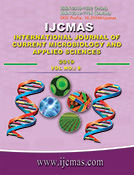


 National Academy of Agricultural Sciences (NAAS)
National Academy of Agricultural Sciences (NAAS)

|
PRINT ISSN : 2319-7692
Online ISSN : 2319-7706 Issues : 12 per year Publisher : Excellent Publishers Email : editorijcmas@gmail.com / submit@ijcmas.com Editor-in-chief: Dr.M.Prakash Index Copernicus ICV 2018: 95.39 NAAS RATING 2020: 5.38 |
An experiment was conducted during 2009-10 and 2010-11 at research farm of division of Agronomy, IARI, New Delhi, to study the effect of various doses and methods of zinc application on maize and wheat. The treatment consisted of control, 12.5 kg ZnSO4 ha-1, 25 kg ZnSO4 ha-1 and foliar spray of 0.5 % ZnSO4 and two wheat Varieties ‘DBW 17’ and ‘PBW 343’. The grain, stover and biological yield of maize were significantly influenced by application of zinc during first year and the maximum yields were recorded with the application of 25 kg ZnSO4 ha-1 during both the year. During first year application of 25 kg ZnSO4, 12.5 ZnSO4 ha-1 and foliar spray of 0.5 % ZnSO4 increased grain yield by 22.81, 18.63 and 8.36 percent respectively over control, while 4.10, 2.41 and 1.69% increase in grain yield was recorded during second year. In wheat, application of 25 kg ZnSO4 ha-1 significantly increased 1000 grain weight during both the years while during second year effective tiller m-2, grain spike-1 and grain diameter; as compared to the remaining treatment. This treatment increased the number of effective tillers by 6, 10 and 11 percent over the application of 12.5 kg ZnSO4 ha-1, foliar spray and control, respectively, during second year. Direct application of zinc to wheat varieties i.e. ‘DBW 17’ and ‘PBW 343’ showed significant variation in grain, straw and biological yield and harvest index during both the years. The yield advantage of 0.35, 0.26 and 0.28 and 0.43, 0.13 and 0.29 t ha-1 was recorded with the application of 25 kg ZnSO4 ha-1 over control, 12.5 kg ZnSO4 ha-1 and foliar spray, respectively. Highest straw and total biological yields were obtained with the application of 25 kg ZnSO4 ha-1.
 |
 |
 |
 |
 |